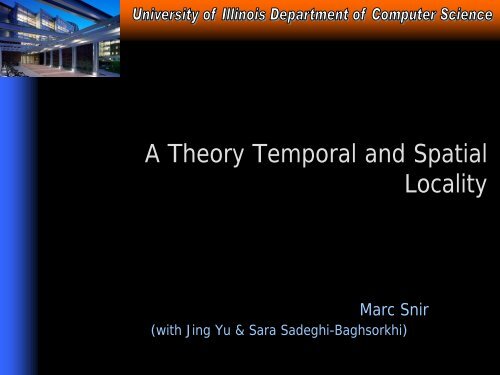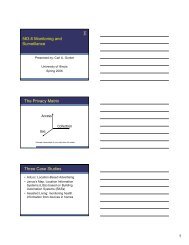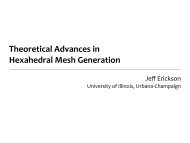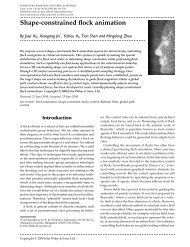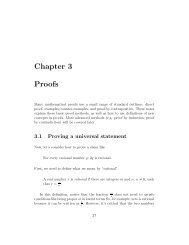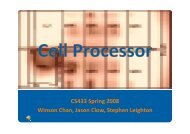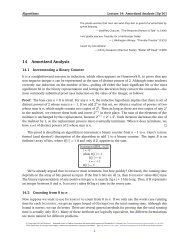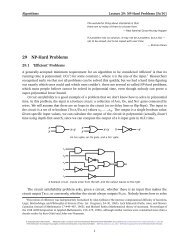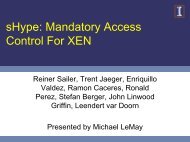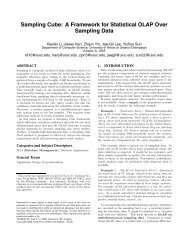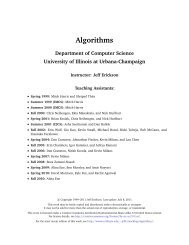Temporal and Spatial Locality - Department of Computer Science
Temporal and Spatial Locality - Department of Computer Science
Temporal and Spatial Locality - Department of Computer Science
You also want an ePaper? Increase the reach of your titles
YUMPU automatically turns print PDFs into web optimized ePapers that Google loves.
A Theory <strong>Temporal</strong> <strong>and</strong> <strong>Spatial</strong><br />
Marc Snir<br />
(with Jing Yu & Sara Sadeghi-Baghsorkhi)<br />
<strong>Locality</strong>
Marc Snir<br />
Caching & <strong>Locality</strong><br />
CPU<br />
L1<br />
L2<br />
L3<br />
memory<br />
disk<br />
�Caches & memory hierarchy<br />
� higher levels are smaller <strong>and</strong><br />
faster<br />
� maintain copies <strong>of</strong> data from<br />
lower levels<br />
� provide illusion <strong>of</strong> fast access<br />
to larger storage, provided that<br />
most accesses are satisfied by<br />
cache<br />
� work if memory accesses<br />
exhibit good locality <strong>of</strong><br />
references<br />
2 Nov-05
Marc Snir<br />
<strong>Locality</strong> <strong>of</strong> References (Wikipedia)<br />
� <strong>Temporal</strong> locality<br />
�The concept that a resource that is referenced at one point<br />
in time will be referenced again sometime in the near<br />
future.<br />
� <strong>Spatial</strong> locality<br />
�The concept that likelihood <strong>of</strong> referencing a resource is<br />
higher if a resource near it was just referenced.<br />
� Assume that temporal <strong>and</strong> spatial locality can be<br />
defined intrinsically as a property <strong>of</strong> the reference<br />
stream, with no connection to cache features<br />
3 Nov-05
Marc Snir<br />
An Operational Definition <strong>of</strong> <strong>Locality</strong><br />
�Good temporal locality ⇒ cache miss traffic<br />
decreases fast when cache size increases<br />
�Good spatial locality ⇒ cache miss traffic<br />
does not increase much when line size<br />
increases<br />
4 Nov-05
Marc Snir<br />
The Naïve View<br />
1. <strong>Temporal</strong> locality <strong>and</strong> spatial locality are<br />
intrinsic to the reference stream – do not<br />
depend on cache parameters<br />
2. Each can be defined using one (or few<br />
parameters)<br />
3. <strong>Temporal</strong> locality determine sensitivity to<br />
cache size <strong>and</strong> spatial locality determine<br />
sensitivity to line size.<br />
� We show that 1 <strong>and</strong> 3 contradict <strong>and</strong> 2 is false<br />
5 Nov-05
Marc Snir<br />
Definitions<br />
� Hit A (M,L) – Hit rate (fraction <strong>of</strong> accesses that are<br />
cache hits) for sequence A <strong>of</strong> accesses for a (LRU,<br />
fully associative) cache <strong>of</strong> size M, with cache lines <strong>of</strong><br />
length L (L divides M)<br />
� Miss A (M,L) = 1-HIT A (M,L) – Miss rate<br />
� MT A (M,L) = L × Miss A (M,L) – Miss traffic<br />
� Good temporal locality = MTA (M,L) decreases fast<br />
when M increases<br />
� Good spatial locality = MTA (M,L) does not increase<br />
much when L increases (the miss rate decreases<br />
almost by a factor <strong>of</strong> L)<br />
6 Nov-05
Marc Snir<br />
Is “LRU” Essential to the Definition?<br />
�Def: Online cache management algorithm<br />
Offline cache management algorithm<br />
OPT (optimal <strong>of</strong>fline cache management<br />
algorithm) – furthest future use<br />
Assume L=1<br />
Def: Cache management ALG is c(M,m) –<br />
competitive if for any sequence <strong>of</strong> accesses A<br />
Miss A ALG(M) ≤ c(M,m) × Miss A OPT(m)<br />
7 Nov-05
Marc Snir<br />
Competitive Analysis<br />
�Thm (Sleator & Tarjan):<br />
� LRU is M/(M-m+1) competitive<br />
� If an online algorithm is c-competitive then c ≥<br />
M/(M-m+1)<br />
�Same result is valid for other common cache<br />
replacement algorithms, e.g. FIFO, RANDOM,<br />
etc.<br />
⇒ “LRU” is not an essential part <strong>of</strong> the<br />
definition<br />
8 Nov-05
Marc Snir<br />
Is “Fully Associative” Essential?<br />
�Direct mapped cache <strong>of</strong> size M can behave, in<br />
the worst case, as a fully associative cache <strong>of</strong><br />
size 1.<br />
�Problem can be avoided if addresses are<br />
hashed<br />
�Def: H is a Universal Hash Function if it is a<br />
class <strong>of</strong> functions h:A→B such that, for any x,<br />
y ∈ A, <strong>and</strong> r<strong>and</strong>omly chosen h ∈ H,<br />
Prob[h(x)=h(y)] = 1/|B|.<br />
H is k-independent if for any a 1 ,…,a k ∈ A , b 1,…,b k<br />
∈ B, Prob[h(a 1)=b 1,…,h(a k)=b k] = 1/|B| k<br />
9 Nov-05
Marc Snir<br />
Hashed Dircet Mapped Cache<br />
� Miss A Hash(M) – miss rate on direct mapped<br />
cache <strong>of</strong> size M, assuming that addresses<br />
are hashed using a universal hash function.<br />
� Thm:<br />
1. E[Miss A Hash (M)] ≤ M/(M-m+1) (MissA OPT (m)+m)<br />
2. If H is m-independent <strong>and</strong> Miss A LRU(m) < ε<br />
then Miss A Hash(m/ε) < 2ε<br />
10 Nov-05
Marc Snir<br />
Outline <strong>of</strong> Pro<strong>of</strong> for 1<br />
�Use potential function<br />
� Φ i – number <strong>of</strong> elements that are both in the<br />
cache <strong>of</strong> Hash <strong>and</strong> in the cache <strong>of</strong> OPT at step i<br />
� ΔΦ i = Φ i - Φ i-1<br />
� δi ALG indicator function for misses<br />
� Xi = δi Hash -M/(M-m+1) (δi OPT +Δ Φi )<br />
∑ X i = Miss Hash – M/(M-m+1) (Miss OPT +Φ n-Φ 0)<br />
Show that E[X i ] ≤ 0 by simple case analysis<br />
11 Nov-05
Marc Snir<br />
Synthetic Traces<br />
� Hypothesis: Memory traces can be meaningfully<br />
characterized using a few parameters<br />
� Informal Def: two memory traces are similar (T 1 ≈<br />
T2) if, for any cache size, both traces result in<br />
Taaa 1 ∼ T2<br />
approximately the similar me hit rates.<br />
� The synthetic trace hypothesis: One can define a<br />
parametric family <strong>of</strong> stochastic traces T(θ 1, …, θ k) so<br />
that, for any application trace T, there is a set <strong>of</strong><br />
parameter values a 1,…,a k so that T ≈ T(a 1,…,a k ).<br />
� (Stone, Eeckhout, Stromaier,…)<br />
12 Nov-05
Marc Snir<br />
Hypothesis is Wrong<br />
� Intuition: any monotonic nonincreasing graph can<br />
represent miss traffic (miss rate) as function <strong>of</strong><br />
cache size for some memory trace<br />
� Formal theorem: Given ε >0, 0 < m 1
Marc Snir<br />
Informal Pro<strong>of</strong><br />
A sequence <strong>of</strong> accesses <strong>of</strong> the form<br />
(a 1 1 …am1 +1 1 ) n1 …(a 1 i …ami +1 i ) ni…<br />
will have m i(n i -1) accesses that miss for cache<br />
<strong>of</strong> size m i but do not miss for larger cache.<br />
Theorem follows by choosing n i so that (n i-1)<br />
≈ λ (p i-1 –p i), for suitable constant λ.<br />
14 Nov-05
Marc Snir<br />
Reuse<br />
15 Nov-05
Marc Snir<br />
Theorem<br />
�A measure <strong>of</strong> temporal locality that predicts<br />
sensitivity <strong>of</strong> cache miss b<strong>and</strong>width to cache<br />
size must depend on line size<br />
�A measure <strong>of</strong> spatial locality that predicts<br />
sensitivity <strong>of</strong> cache miss b<strong>and</strong>width to line<br />
size must depend on cache size<br />
16 Nov-05
Marc Snir<br />
Pro<strong>of</strong> Outline<br />
�We disprove the following:<br />
small cache large cache<br />
short line m,1 M,1<br />
long line<br />
m,L M,L<br />
� Increased cache size significantly decreases miss<br />
traffic for line size 1 iff it does so for line size L<br />
� Increased line size significantly increases miss<br />
traffic for cache size m iff it does so for cache size M<br />
17 Nov-05
Marc Snir<br />
Four counterexamples<br />
m,1 M,1<br />
m,L M,L<br />
good T.L. for short lines but<br />
bad T.L. for long lines<br />
m,1<br />
m,L<br />
M,1<br />
M,L<br />
bad S.L. for small cache but<br />
good S.L. for large cache<br />
m,1 M,1<br />
m,L M,L<br />
bad T.L. for short lines but<br />
good T.L. for long lines<br />
m,1 M,1<br />
m,L M,L<br />
good S.L. for small cache but<br />
bad S.L. for large cache<br />
18 Nov-05
Marc Snir<br />
Pro<strong>of</strong> Outline<br />
(a,a+L,…,a+(m-1)L) α … (misses in m,L)<br />
(b,b+1,…,b+M-1) β ... (misses in m,1 <strong>and</strong><br />
m,L)<br />
(c,c+L,…,c+(M-1)L) γ ... (misses in m,1 m,L<br />
<strong>and</strong> M,L)<br />
(d,d+1,…,d+M) δ (misses in all)<br />
� Large α: bad spatial locality for m but good spatial locality for<br />
M<br />
� Large γ: good spatial locality for m but bad spatial locality for<br />
M<br />
� Etc.<br />
19 Nov-05
Marc Snir<br />
This is not only theory<br />
� R<strong>and</strong>omAccess benefits from larger cache for small line size<br />
but not large line size<br />
� CG benefits from larger cache for large line size but not small<br />
line size<br />
20 Nov-05
Marc Snir<br />
<strong>Spatial</strong> <strong>Locality</strong> Revisited<br />
�Previous analysis assumed that variables<br />
cannot be remapped in memory during<br />
execution; in practice such remapping is<br />
possible (e.g. during garbage collection <strong>and</strong><br />
memory compaction). Can this be used to<br />
improve spatial locality?<br />
�Model: Caching with Rearrangements. When<br />
a line has to be evicted can pick L arbitrary<br />
items from the cache <strong>and</strong> store them in a<br />
memory line frame<br />
�RMiss – miss rate in rearrangeable caching.<br />
21 Nov-05
Marc Snir<br />
Rearrangeable Model<br />
�Thm:<br />
�LRU is L(M-L)/(M-m) competitive in<br />
rearrangeable model<br />
�If ALG is a c-competitive online algorithm in<br />
the rearrangeable model then<br />
c ≥L(M-L 2 +2L)/(M-m+L)<br />
Online algorithms “loose” a factor <strong>of</strong> L in the<br />
rearrangeable model – spatial locality cannot<br />
be managed online<br />
22 Nov-05
Marc Snir<br />
Open Problems<br />
�Close gap between u.b. <strong>and</strong> l.b in last<br />
theorem<br />
�Describe what is the optimal <strong>of</strong>fline algorithm<br />
for the rearrangeable model.<br />
23 Nov-05
Marc Snir<br />
References<br />
� Marc Snir <strong>and</strong> Jing Yu. On the Theory<br />
<strong>of</strong> <strong>Spatial</strong> <strong>and</strong> <strong>Temporal</strong> <strong>Locality</strong> . Technical<br />
Report No. UIUCDCS-R-2005-2611,<br />
<strong>Department</strong> <strong>of</strong> <strong>Computer</strong> <strong>Science</strong>, UIUC, July<br />
2005.<br />
�Jing Yu, Sara Baghsorkhi <strong>and</strong> Marc Snir. A<br />
New <strong>Locality</strong> Metric <strong>and</strong> Case Studies for<br />
HPCS Benchmarks . Technical Report No.<br />
UIUCDCS-R-2005-2564, <strong>Department</strong> <strong>of</strong><br />
<strong>Computer</strong> <strong>Science</strong>, UIUC, April 2005<br />
24 Nov-05


